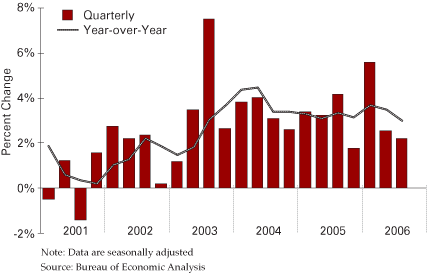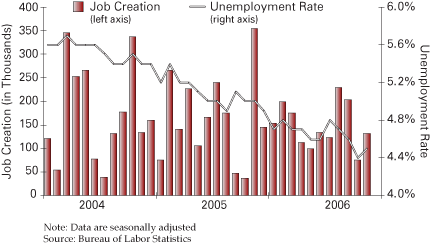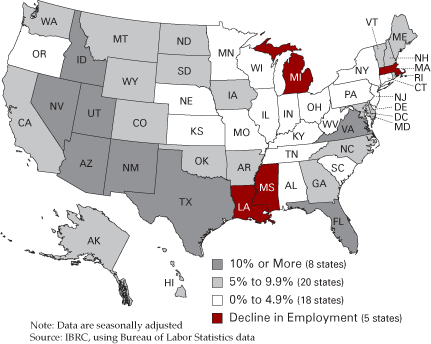The U.S. Economy
Indiana University, Bloomington
Overall, 2006 will end up as a pretty good year for the U.S. economy, although not in all dimensions. Growth in total output (GDP) should be close to 3.3 percent (see Figure 1). Payroll employment will have grown by about 1.8 million, and the unemployment rate will have declined by about one-half point (see Figure 2). The output and employment numbers come close to matching our relatively optimistic outlook from a year ago, while the unemployment result is better than we expected.
Figure 1
U.S. Real Output

Figure 2
U.S. Job Creation and Unemployment

But there are also some less positive aspects to the current situation. To begin with, the growth in both output and employment decelerated during 2006. At the same time, inflation increased. This was driven in part by a tightening labor market and in part by a significant jump in energy prices. Elevated inflation caused the Federal Reserve to push short-term interest rates upward by more than we anticipated a year ago. (On the other hand, long-term rates have risen only slightly and are actually below our expectation.) Finally, the situation in the housing sector has deteriorated more than we foresaw.
Given this somewhat ambiguous state of affairs, we expect an acceptable performance from the economy in 2007, but not up to the standards of the past few years. There are enough risks in the current situation, however, that a weaker outcome is a clear possibility.
The key to this unfolding drama will be the American consumer. From the end of the recession in 2001 through the end of 2005, consumption spending accounted for 78 percent of the increase in output, with spending on housing construction comprising another 13 percent. Consumption has held up pretty well during the past year, comprising 70 percent of growth in the first three quarters of 2006. Housing, on the other hand has become severely negative, cutting about 0.6 percent from the output growth rate. Part of the decline in residential investment has been made up by business investment and by healthy growth in exports.
We expect a continuation of this basic pattern—consumption at a level that is adequate to maintain forward momentum in spite of continuing declines in the housing sector. Some details:
- We expect real output to grow about 3 percent in 2007. That will be below the 2006 figures and also somewhat below the long-run potential of the economy.
- Employment will expand by about 1.7 million. This may be enough to bring the unemployment rate down slightly. For Indiana, this national situation will imply a continuation of the pattern shown in Figure 3.
- Inflation will moderate a little from 2006, with an assist from relative stability in energy prices. The consumer price index will increase about 3 percent.
- The Federal Reserve will keep the federal funds rate at its current 5.25 percent for most of 2007. There may be some reduction late in the year. Long-term rates, on the other hand, may increase somewhat.
Figure 3
Percent Change in Employment by State, September 2000 to September 2006

As mentioned earlier, the key to this outcome is the economic behavior (and psyche) of U.S. households. The household sector is currently being buffeted by a variety of opposing forces.
The most important of these is the labor market situation—employment growth and the income it produces. Although job creation recently has been nothing like the late 1990s, it has been sufficient to pull unemployment lower, to keep income growing, and to keep workers relatively optimistic about their prospects. We expect these trends to continue. Our outlook implies about 140,000 new jobs per month. If job creation were to slow to 100,000 per month or lower, the economic growth we expect for next year would be unlikely.
A second important factor will be the evolution of the housing sector retrenchment. We expect that housing construction will continue to weaken through most of 2007. But as 2006 has demonstrated, this alone is not sufficient to bring the overall economy down. What will be crucial is the behavior of housing values. If home prices start to decline significantly in more than just a few markets, it could become a significant drag on the willingness and ability of households to continue to spend. Any further increases in interest rates by the Federal Reserve would raise the probability of this scenario.
A third risk is the possibility that energy prices again head higher. This would pressure households from several directions. To begin with, it would tighten budgets and drain spending power away from other things. It could also reverse the moderation in inflation we expect. This in turn would very likely force the Fed to further raise interest rates, which would put still more strain on household budgets.
Beyond the household sector, there is a long list of risks to the economic outlook—both short-term and long-term. The geopolitical environment has certainly not improved during the past year. At home, the federal budget has improved; but even after three years of strong growth and a rapid increase in revenues, there are still large deficits. In addition, personal saving has fallen steadily during the past decade, meaning that total national saving is very low. The flip side of the low national saving is our large trade deficit, which continued to grow during 2006 and now accounts for more than 6 percent of GDP. At some future point, these trends will have to be reversed.
Returning to the here and now, in spite of the problems on the horizon, we feel that the U.S. economy will come through 2007 with an acceptable performance. The crucial household sector faces pressures on several fronts, but recent developments are mildly encouraging. While there are definitely risks, there are enough positives to sustain moderate economic growth.
Also in this Issue…
- Outlook for 2007
- The International Economy
- The U.S. Economy
- Financial Forecast
- Housing
- Indiana Agriculture
- Indiana
- Anderson and Muncie
- Bloomington
- Columbus
- Evansville
- Fort Wayne
- Gary
- Indianapolis
- Kokomo
- New Albany
- Richmond
- South Bend and Elkhart-Goshen
- Terre Haute
- Indiana Metro Economies at a Glance
- Return to Table of Contents



